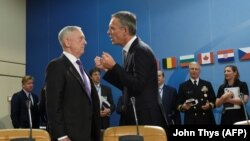BRUSSELS -- NATO has announced it will increase the number of troops in Afghanistan from the current 13,000 to 16,000 to aid the Kabul government in its fight against the Taliban.
Secretary-General Jens Stoltenberg made the announcement on November 9 at the end of a two-day meeting of the alliance's defense ministers in Brussels.
Stoltenberg reiterated that the extra troops would not be involved in combat missions but would be part of NATO's Resolute Support mission, whose aims is to train, advise, and assist the Afghan government forces.
"Currently, around 13,000 troops from 39 different countries serve in our Resolute Support mission," Stoltenberg told a news conference after the meeting.
"Allies welcomed the United States briefing on the implications of the new South Asia strategy on our mission. This has already led to an increase in the U.S troop contribution, and 27 other nations have also committed to increase troop numbers in the coming months," Stoltenberg said.
"So the size of our Resolute Support mission will increase, from around 13,000 to around 16,000 troops."
U.S. Defense Secretary Jim Mattis lauded the commitment shown by most NATO member states toward beefing up the Afghan mission.
"Over two dozen nations have stated that they intend to raise the troop numbers that they have on the ground there now, including some very small nations for whom this is the largest overseas deployment they have been engaged in," Mattis said after the meeting. "We appreciate their commitment to stabilizing the South Asia region."
However, the alliance's pledge still falls short of commitments, U.S. commanders said November 9. They told the defense ministers' meeting that nearly three months after Trump announced his South Asia strategy, the promised troop numbers don't expand the NATO training presence as much as hoped.
They declined to say what percentage had been filled after the meetings, but acknowledged that there was still a shortfall. NATO officials speaking on condition of anonymity confirmed after the meeting that there would be a shortfall approaching 10 percent.
"We have made it very clear to the allies that we really need their help in filling these billets that we have identified," General John Nicholson, the top U.S. commander in Afghanistan and head of Resolute Support, said after the Brussels meeting.
The gap, Nicholson said, has contributed to the lowest level of capabilities and the "highest level of risk we faced" in the 16-year war.
U.S. Army General Curtis Scaparrotti, NATO's top military officer, also stressed that the level of troops was still not high enough. "Coming out of today, it won't be at 100 percent today," he said.
"We're still in discussion with more than a few nations that are looking at an increase above the initial one.... So, I'm encouraged," he added.
Two unnamed diplomats told Reuters that at this stage, the United States is likely to provide 2,800 troops, while non-U.S. NATO allies and partners will send an additional 700 troops, potentially making up a 3,500-strong personnel increase.
The United States led an invasion to drive Taliban extremists from power after Al-Qaeda militants whose leaders were sheltering in Afghanistan killed nearly 3,000 people in the September 11, 2001, attacks on the United States.
The United States, NATO, and other partners had more than 100,000 troops in Afghanistan for a time, but the Taliban has been resurgent since NATO ended combat operations in 2014. The extremist group Islamic State (IS) has also stepped up attacks.
With reporting by Rikard Jozwiak in Brussels, dpa, and AP







